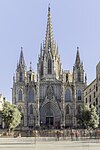Palau Reial Major

The Palau Reial Major (Catalan pronunciation: [pəˈlaw rəˈjal məˈʒo]; "Grand Royal Palace") is a complex of historic buildings located in Plaça del Rei, Barcelona, Catalonia, Spain. It was a residence of the counts of Barcelona and kings of Aragon. It is composed of three distinct edifices: the Saló del Tinell, built by King Peter IV in 1359–1362 the Palatine Chapel of St. Agatha (1302), built under King James II the Palau del Lloctinent (1549), built by Generalitat of Catalonia under Charles VThe Saló del Tinell was built in the 14th century under the direction of architect Guillem Carbonell. Its gothic round arches are founded over 11th-century vaults (built themselves over a pre-existing monumental structure dating to the Visigoth age). The Chapel of St. Agatha was designed by architect Bertran Riquer to act as the royal chapel, replacing a previous oratory. It has an octagonal tower from the early 14th century, and it consists of a single aisle with a roof ceiling and ends with a polygonal apse. The sacristy is built within the ancient Roman walls. By commission of Peter V of Aragon (1463–1466) painter Jaume Huguet made the chapel altarpiece dedicated to the Epiphany. Both Saló del Tinell and St. Agatha Chapel are valuated as Catalan Gothic architecture masterpieces. The Epiphany altarpiece is also an outstanding gothic painting. They can be visited as a part of the Barcelona City History Museum MUHBA. Temporary exhibitions are held in them. After the 16th century, the edifice was no longer used as a royal residence and was divided between the Inquisition and the royal administration. In this period, the door leading to the Royal Audience Hall was built, with a triangular tympanum (currently at the entrance of the Museu Frederic Marès). The Palau de Lloctinent was built in 1549–1557 by Antoni Carbonell, in late Gothic-Renaissance style as the residence of the Viceroy (Lloctinent) of Catalonia. Also from this period is the so-called Mirador of King Martin, a five-storey tower on a rectangular plan (1555).
Excerpt from the Wikipedia article Palau Reial Major (License: CC BY-SA 3.0, Authors, Images).Palau Reial Major
Plaça del Rei, Barcelona
Geographical coordinates (GPS) Address Nearby Places Show on map
Geographical coordinates (GPS)
| Latitude | Longitude |
|---|---|
| N 41.384163888889 ° | E 2.1775666666667 ° |
Address
Capella de Santa Àgata
Plaça del Rei 10
08001 Barcelona (Ciutat Vella)
Catalonia, Spain
Open on Google Maps











